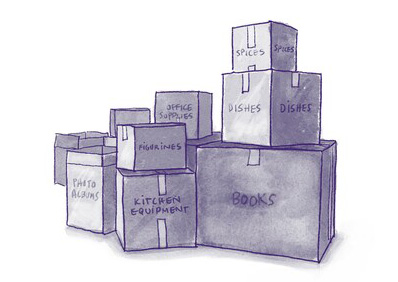
Instructor Alison Garwood-Jones is using the marketing skills she teaches at SCS to reach the right audience for her new book about navigating grief.
This month SCS marketing instructor Alison Garwood-Jones launched “I Miss My Mommy”, a graphic novel for orphaned adults.
Following the back-to-back losses of her parents in 2011 and 2012, Garwood-Jones originally started working on the drawings that would eventually fill her book as a way for her to process her own experience.
“For a long time I focused on writing as my main art, largely because I was earning a living as a magazine feature writer, but after my parents passed, I picked up my pen again. Drawing, for me, and I think for all people, is an easy way into different kinds of emotions,” she says.
At the time, Garwood-Jones wasn’t ready to deal with big emotions, and found the idea of processing them through large-scale art, whether it be large, intimidating paintings, or epic orchestral music, didn’t work for her.
“That’s how some big pieces of art made me feel during the height of the grief, is remoteness, like big orchestral numbers, I can't listen to Wagner or even Mozart when I'm grieving, that's too big, I need to go small. I've always loved the expression ‘think small’. We live in a culture that's very ‘go big or go home’, and I think when it comes to tough topics, thinking small is actually more powerful, because it gives people a way into something tough through something manageable,“ she explains.
“I found that spot illustrations, which is what this book relies on, were an effective way for me to process my own emotions.”
When Garwood-Jones shared those illustrations on social media she found that other people dealing with grief could instantly relate and connect emotionally to what the illustrations represented. For example, one illustration simply features a pile of boxes.
“I thought, Gen Xers who've lost their parents, same with Baby Boomers, are going to understand boxes, because on these boxes, you're going to have labels like kitchen supplies, books, office supplies, this is all the stuff that's left behind after a life,” she says.

“Part of grief is dealing with the admin tasks, with the storage units, and if I can show those responsibilities that the kids take on afterwards, just through a drawing of a pile of boxes, then maybe I can connect with people on a level that makes them feel seen, or maybe sometimes just gives them a bit of a chuckle. I don't know if I achieved it but I'm going for, not just comfort and compassion, but a little comic relief maybe.”
Garwood-Jones says these days she looks at grief as two things. “It’s dealing first with absence, like, ‘oh, my God, mom and dad are gone, they're never coming back’. And then it's dealing with presence. And the rest of your life, you're dealing with their presence,” she explains.
“For some people, that's an inspiration, because it carries you forward, the lessons they taught you, and what they showed you in terms of how they were resilient in life and how they handled challenges. If they did it in a way that was level -headed and strong, that is a gift that keeps on giving. So somehow in the aftermath of death, you're left with inspiration, if you're lucky. But a lot of people are left just feeling plain injured. You know, and because their parents, for whatever reason, again, couldn't be the parents they needed. Some people are not meant to be parents, but they still have kids, and it leaves behind a lot of injured souls. So I wanted my book to show that as well. There's a lot of walking wounded out there.”
Marketing a book on grief is a particularly delicate operation, and Garwood-Jones says that while of course she hopes the book will reach people it might help, she wants to connect with her audience in a way that feels authentic.
“I'm part of that generation of writers now, and it's picking up steam big time, who wants to bypass Amazon, and sell directly to my readers. We live in an age where you can bypass the middlemen and the middlewomen. We've seen that in music with Taylor Swift and Beyonce. And I think writers are catching on now that there's a lot of technology out there, from a content platform point of view, from an e-commerce point of view, from a distribution point of view, that we can handle this on our own,” she says.
“It's a steep learning curve. But I mean, legacy media is burning, and there are other ways. From burnt earth, there comes little green shoots. And I think one of the green shoots that is growing right now is this growing awareness from authors, by authors, that I can have this direct relationship with my audience and I can grow that. It's not the route to go if you want to be rich and famous. But if you care about your topic, and you care about what your audience would need from you in terms of your topic, you can grow something on a very sort of one-on-one basis slowly. It's a marathon, not a sprint.”
Garwood-Jones says it all makes for the perfect case study she can take back to her SCS classes.
“Right now is a very, very interesting time to be putting something new out onto the internet because the internet is a mess right now. It's scrambled eggs, and part of the reason it's scrambled eggs is that it's been flooded with AI-generated content. There's a ton of synthetic content out there that's been trained on content by humans,” she says.
“So the question is how do I rise above the noise and create something unique with a new point of view and a unique voice and a more compelling approach to a particular topic. This is where I've got to test things out. I can take this back to class and say, ‘okay, when I went really super long tail on the topic of grief, did that help with my ranking in terms of, not being necessarily an expert, but being someone who is joining the conversation online about grief?’”
Another thing Garwood-Jones says she will take back to her class is that she is taking a very one-on-one approach to marketing such a personal book. “I actually do want to have a meaningful one-on-one connection with every single person that purchases from me and sends me a note,” she says.
“So I'm writing handwritten notes, sending them back a thank you with a custom bookmark for their book. I do that because I want them to feel good, but being kind makes me feel good. One of the best remedies for when you're feeling depressed or sad or stuck is to help somebody else. Do something nice for somebody else,” she says.
“I know that that doesn't work for clinical depression and I'm not an expert at all, but for when we've got the blues or the mean reds, as Audrey Hepburn used to like to say, doing something kind for somebody else and connecting with them can really help.”
Alison Garwood-Jones is a Toronto-based author, illustrator, and podcast host. She started her career as an art historian working at the Art Institute of Chicago, The Musée d'Orsay in Paris and The Smithsonian's National Portrait Gallery and went on to become a magazine editor (Elle) and feature writer with a focus on culture, technology, and health.
She currently teaches: Foundations of Digital Communications Strategy and Social Media; Digital Communications Strategy: Defining Your Business Objective; Digital Communications Strategy: Content Marketing and Distribution; and Writing Digital Content.
